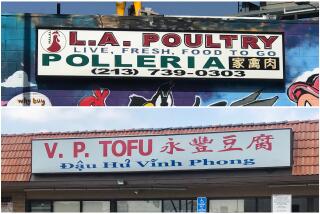Urban Village: A Grab Bag of Goals
The 1990s are just two weeks old, and already planning and development has its first cliche of the decade: urban villages.
That catch phrase is being pinned on almost every development plan calling for an increase in density under the guise of a desirable mix of residential, retail and office uses in a pedestrian-friendly setting.
The plans range from picturesque visions of old towns and sensitively clustered communities to pricey resorts draped in nostalgic styles, walled subdivisions garnished by a shopping center and/or a golf course, and bland assemblages of landscaped commercial buildings at freeway interchanges.
In Southern California, the phrase is being arbitrarily used to describe the varied proposals for 8,000-acre California Springs near Lancaster, 880-acre Playa Vista south of Marina del Rey, sections of the sprawling Porter Ranch in the west San Fernando Valley and a variety of less ambitious efforts.
Ironically, the phrase was coined 30 years ago in a book by sociologist Herbert Gans entitled “The Urban Villagers” to describe a predominately Italian, aging, stable low-income neighborhood in Boston.
At present, the urban village concept can be characterized by the tendency to be neither urban nor a village. Rather, it seems a grab bag of sorts of planning and design goals and guidelines, some praiseworthy and some questionable, and all worthy of debate.
The focus of the concept is decidedly exurban, not blurred by the messy existing development that defines our city and its suburbs.
But then, building new communities always has been a lot more fun, and profitable, for architects and planners than rehabilitating and recycling old ones, especially those encumbered with unsightly buildings and entrenched residents.
The goals of the urban village generally encourage the shaping of a new/old town in a spirit and style that promotes a sense of place, such as providing inviting public plazas. Usually illustrating the goals are chimerical renderings, or selective photos of Seaside, a celebrated speculative second-home community in the Florida panhandle featuring picture book designs.
Although accused of being more concerned with style than substance, the illustrations are attractive, especially when compared to the dull, monochromatic residential muck that marks most suburban and recreational resort subdivisions.
The various urban village guidelines call for the clustering of housing, with a sprinkling of retail, offices and public buildings and spaces, to form a neighborhood that proponents describe as neo-traditionalist. The effect appears to have the flavor of a sort of shake-and-bake residential historic district, cozy and communal.
In addition, one group of involved designers has urged that these neighborhoods, which they label “pedestrian pockets,” be organized around mass transit stations that everyone could walk to.
It is an admirable, if wistful, idea, not unlike the one that spurred the early development of Los Angeles along an extensive interurban rail system.
Other guidelines include architectural standards advocating a down-home look consistent with romantic regional styles, set in a network of narrow streets and alleys laid out in a right-angled grid pattern that hearkens back to the so-called garden city town planning concepts of a century ago.
The grid pattern is the organizing holy grail of urban villages, theoretically dispersing traffic rather than channeling it in a hierarchy of collector streets as in most planned-unit developments today.
Among the problems with this vision is that the grid destroys the potential of a redeeming greenbelt system that the garden city concept promoted and that better-planned subdivisions of late have embraced, and which parents and children love because it eliminates most cross streets.
Not coincidentally, the grid system, with all its inherent traffic problems, also consumes considerably more open space, and in a diverse landscape, is less environmentally sensitive. What it does do, of course, is generate more buildable lots. It was that, not its aesthetic potential, that originally motivated its use in cities.
These greenbelts or green ways formed by a road system ending in cul-de-sacs are what made such planned developments as the Turtle Rock section of Irvine in Orange County so attractive to families--the greenbelts becoming, in effect, the community’s focal point.
It is interesting to note that as the green-way concept in Irvine was compromised for increased densities and maintenance concerns in more recent developments there, such as in the Westpark section, the town lost some of its unique character to become just another well-packaged collection of subdivisions.
If there is a solution to the noxious increase of through traffic in established residential neighborhoods such as in Los Angeles, it is selective cul-de-sacing, with the dead ends landscaped as parks and playgrounds. Here would be a start in developing public spaces advocated by those promoting urban villages.
There is much to commend about some urban village concepts, in particular the emphasis on a public realm and a diversity of building styles and uses organized to wean people from their cars.
However, there is something elitist about the urban village concept--a designer-knows-best feeling that hints at a dogmatic approach to planning that could be just as repressive to healthy community development as the current strict single-use zoning practices.
There also is the feeling that the varied concepts are less a design tool and more a marketing scheme, based upon the public’s yearning for a sense of community that neighborhoods of old offered. I worry that once the concept is approved, compromises will start, and in the end the only ones who will benefit are the designers and the developers.
Some old-fashioned skepticism is needed to see beyond the fanciful phrasing and renderings accompanying the urban village concept, the kind of skepticism that rose like steam from the locals sitting on the front stoops of city neighborhoods or around the pot-bellied stoves of the village general stores of our memories.
More to Read
The biggest entertainment stories
Get our big stories about Hollywood, film, television, music, arts, culture and more right in your inbox as soon as they publish.
You may occasionally receive promotional content from the Los Angeles Times.










